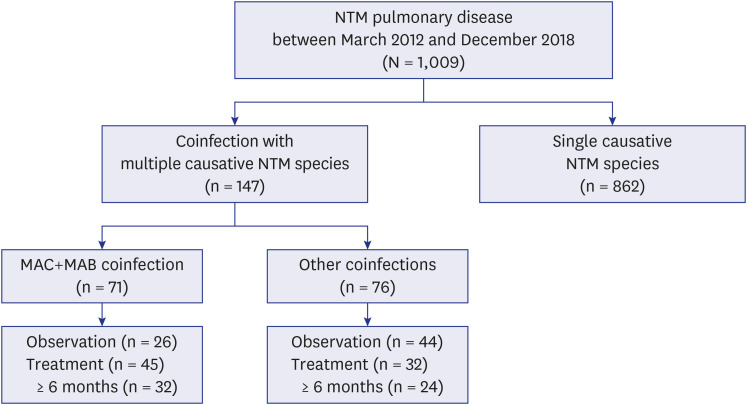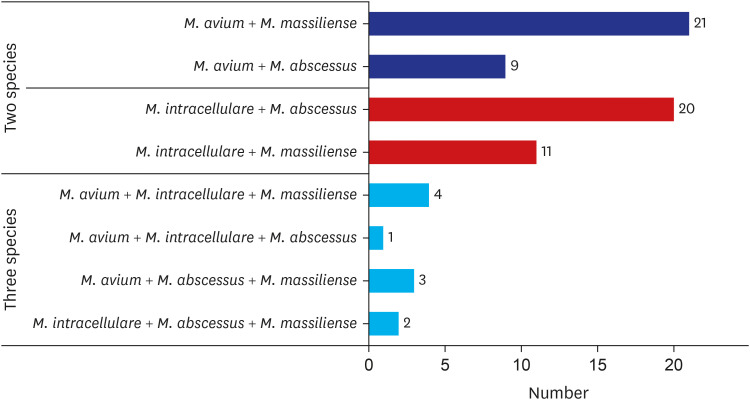J Korean Med Sci.
2024 May;39(20):e167. 10.3346/jkms.2024.39.e167.
Clinical Characteristics and Treatment Outcomes of Pulmonary Diseases Caused by Coinfections With Multiple Nontuberculous Mycobacterial Species
- Affiliations
-
- 1Division of Pulmonary and Critical Care Medicine, Department of Internal Medicine, Severance Hospital, Yonsei University College of Medicine, Seoul, Korea
- 2Institute of Immunology and Immunological Diseases, Yonsei University College of Medicine, Seoul, Korea
- 3Institute for Innovation in Digital Healthcare, Yonsei University, Seoul, Korea
- KMID: 2556284
- DOI: http://doi.org/10.3346/jkms.2024.39.e167
Abstract
- Background
Coinfections with multiple nontuberculous mycobacterial (NTM) species have not been widely studied. We aimed to evaluate the clinical characteristics and treatment outcomes in patients with NTM-pulmonary disease (PD) caused by coinfection with multiple NTM species.
Methods
We retrospectively reviewed patients with NTM-PD at a tertiary referral hospital in Korea between March 2012 and December 2018. Coinfection was defined as two or more species of NTM pathogens isolated from the same respiratory specimen or different specimens within three months.
Results
Among 1,009 patients with NTM-PD, 147 (14.6%) NTM coinfections were observed (average age 64.7 years, 69.4% women). NTM species were identified more frequently (median 6 vs. 3 times, P < 0.001) in the coinfection group than in the single species group, and follow-up duration was also longer in the coinfection group (median 44.9 vs. 27.1 months, P < 0.001). Mycobacterium avium complex (MAC) and M. abscessus and M. massiliense (MAB) were the dominant combinations (n = 71, 48.3%). For patients treated for over six months in the MAC plus MAB group (n = 31), sputum culture conversion and microbiological cure were achieved in 67.7% and 41.9% of patients, respectively. We divided the MAC plus MAB coinfection group into three subgroups according to the target mycobacteria; however, no statistical differences were found in the treatment outcomes.
Conclusion
In NTM-PD cases, a significant number of multiple NTM species coinfections occurred. Proper identification of all cultured NTM species through follow-up is necessary to detect multispecies coinfections. Further research is needed to understand the nature of NTM-PD in such cases.
Figure
Reference
-
1. Jeon D. Infection source and epidemiology of nontuberculous mycobacterial lung disease. Tuberc Respir Dis. 2019; 82(2):94–101.2. Haworth CS, Banks J, Capstick T, Fisher AJ, Gorsuch T, Laurenson IF, et al. British Thoracic Society Guideline for the management of non-tuberculous mycobacterial pulmonary disease (NTM-PD). BMJ Open Respir Res. 2017; 4(1):e000242.3. Daley CL, Iaccarino JM, Lange C, Cambau E, Wallace RJ Jr, Andrejak C, et al. Treatment of nontuberculous mycobacterial pulmonary disease: an official ATS/ERS/ESCMID/IDSA clinical practice guideline. Eur Respir J. 2020; 56(1):2000535. PMID: 32636299.4. Ryu YJ, Koh WJ, Daley CL. Diagnosis and treatment of nontuberculous mycobacterial lung disease: clinicians’ perspectives. Tuberc Respir Dis. 2016; 79(2):74–84.5. Holt MR, Baird T. Treatment approaches to Mycobacterium abscessus pulmonary disease. Clin Chest Med. 2023; 44(4):785–798. PMID: 37890916.6. Griffith DE, Girard WM, Wallace RJ Jr. Clinical features of pulmonary disease caused by rapidly growing mycobacteria. An analysis of 154 patients. Am Rev Respir Dis. 1993; 147(5):1271–1278. PMID: 8484642.7. Wallace RJ Jr, Zhang Y, Brown BA, Dawson D, Murphy DT, Wilson R, et al. Polyclonal Mycobacterium avium complex infections in patients with nodular bronchiectasis. Am J Respir Crit Care Med. 1998; 158(4):1235–1244. PMID: 9769287.8. Kim JS, Tanaka N, Newell JD, Degroote MA, Fulton K, Huitt G, et al. Nontuberculous mycobacterial infection: CT scan findings, genotype, and treatment responsiveness. Chest. 2005; 128(6):3863–3869. PMID: 16354855.9. Jarand J, Levin A, Zhang L, Huitt G, Mitchell JD, Daley CL. Clinical and microbiologic outcomes in patients receiving treatment for Mycobacterium abscessus pulmonary disease. Clin Infect Dis. 2011; 52(5):565–571. PMID: 21292659.10. Lim HJ, Park CM, Park YS, Lee J, Lee SM, Yang SC, et al. Isolation of multiple nontuberculous mycobacteria species in the same patients. Int J Infect Dis. 2011; 15(11):e795–e798. PMID: 21873093.11. Cowman S, Burns K, Benson S, Wilson R, Loebinger MR. The antimicrobial susceptibility of non-tuberculous mycobacteria. J Infect. 2016; 72(3):324–331. PMID: 26723913.12. Park J, Cho J, Lee CH, Han SK, Yim JJ. Progression and treatment outcomes of lung disease caused by Mycobacterium abscessus and Mycobacterium massiliense . Clin Infect Dis. 2017; 64(3):301–308. PMID: 28011609.13. Shin SH, Jhun BW, Kim SY, Choe J, Jeon K, Huh HJ, et al. Nontuberculous mycobacterial lung diseases caused by mixed infection with Mycobacterium avium complex and Mycobacterium abscessus complex. Antimicrob Agents Chemother. 2018; 62(10):e01105-18. PMID: 30104265.14. Zhang H, Luo M, Zhang K, Yang X, Hu K, Fu Z, et al. Species identification and antimicrobial susceptibility testing of non-tuberculous mycobacteria isolated in Chongqing, Southwest China. Epidemiol Infect. 2020; 149:e7. PMID: 33436128.15. Zhang ZX, Cherng BP, Sng LH, Tan YE. Clinical and microbiological characteristics of non-tuberculous mycobacteria diseases in Singapore with a focus on pulmonary disease, 2012-2016. BMC Infect Dis. 2019; 19(1):436. PMID: 31101082.16. Griffith DE, Aksamit T, Brown-Elliott BA, Catanzaro A, Daley C, Gordin F, et al. An official ATS/IDSA statement: diagnosis, treatment, and prevention of nontuberculous mycobacterial diseases. Am J Respir Crit Care Med. 2007; 175(4):367–416. PMID: 17277290.17. Lee SK, Lee EJ, Kim SK, Chang J, Jeong SH, Kang YA. Changing epidemiology of nontuberculous mycobacterial lung disease in South Korea. Scand J Infect Dis. 2012; 44(10):733–738. PMID: 22720876.18. Shin JH, Cho EJ, Lee JY, Yu JY, Kang YH. Novel diagnostic algorithm using tuf gene amplification and restriction fragment length polymorphism is promising tool for identification of nontuberculous mycobacteria. J Microbiol Biotechnol. 2009; 19(3):323–330. PMID: 19349759.19. Lee H, Park HJ, Cho SN, Bai GH, Kim SJ. Species identification of mycobacteria by PCR-restriction fragment length polymorphism of the rpoB gene. J Clin Microbiol. 2000; 38(8):2966–2971. PMID: 10921960.20. Simmon KE, Pounder JI, Greene JN, Walsh F, Anderson CM, Cohen S, et al. Identification of an emerging pathogen, Mycobacterium massiliense, by rpoB sequencing of clinical isolates collected in the United States. J Clin Microbiol. 2007; 45(6):1978–1980. PMID: 17409204.21. Kim SY, Shin SJ, Jeong BH, Koh WJ. Successful antibiotic treatment of pulmonary disease caused by Mycobacterium abscessus subsp. abscessus with C-to-T mutation at position 19 in erm(41) gene: case report. BMC Infect Dis. 2016; 16(1):207. PMID: 27188784.22. Kim HY, Kook Y, Yun YJ, Park CG, Lee NY, Shim TS, et al. Proportions of Mycobacterium massiliense and Mycobacterium bolletii strains among Korean Mycobacterium chelonae-Mycobacterium abscessus group isolates. J Clin Microbiol. 2008; 46(10):3384–3390. PMID: 18753344.23. van Ingen J, Aksamit T, Andrejak C, Böttger EC, Cambau E, Daley CL, et al. Treatment outcome definitions in nontuberculous mycobacterial pulmonary disease: an NTM-NET consensus statement. Eur Respir J. 2018; 51(3):1800170. PMID: 29567726.24. Kim KJ, Oh SH, Jeon D, Chang CL. Isolation and antimicrobial susceptibility of nontuberculous mycobacteria in a tertiary hospital in Korea, 2016 to 2020. Tuberc Respir Dis. 2023; 86(1):47–56.25. Naito K, Noguchi S, Yatera K, Kawanami T, Yamasaki K, Fukuda K, et al. Coinfection with multiple nontuberculous mycobacteria as a possible exacerbating factor in pulmonary nontuberculous mycobacteriosis: clone library analysis using the 16s ribosomal RNA gene. Chest. 2020; 158(6):2304–2313. PMID: 32599068.26. Kim MJ, Kim KM, Shin JI, Ha JH, Lee DH, Choi JG, et al. Identification of nontuberculous mycobacteria in patients with pulmonary diseases in Gyeongnam, Korea, using multiplex PCR and multigene sequence-based analysis. Can J Infect Dis Med Microbiol. 2021; 2021:8844306. PMID: 33688383.27. Asaoka M, Hagiwara E, Etori S, Higa K, Ikeda S, Sekine A, et al. Identification and characteristics of co-isolation of multiple nontuberculous mycobacteria. Intern Med. 2021; 60(20):3213–3219. PMID: 33896860.28. Fujita K, Ito Y, Hirai T, Kubo T, Maekawa K, Togashi K, et al. Association between polyclonal and mixed mycobacterial Mycobacterium avium complex infection and environmental exposure. Ann Am Thorac Soc. 2014; 11(1):45–53. PMID: 24251904.29. Lee JS, Lee JH, Yoon SH, Kim TS, Seong MW, Han SK, et al. Implication of species change of nontuberculous mycobacteria during or after treatment. BMC Pulm Med. 2017; 17(1):213. PMID: 29262802.
- Full Text Links
- Actions
-
Cited
- CITED
-
- Close
- Share
- Similar articles
-
- Nontuberculous Mycobacterial Lung Disease
- Exploring the Association of Bacterial Coinfections with Clinical Characteristics of Patients with Nontuberculous Mycobacterial Pulmonary Disease
- Study for Clinical Characteristics of Nontuberculous Mycobacterial Pulmonary Diseases
- Diagnosis and Treatment of Nontuberculous Mycobacterial Lung Disease: Clinicians' Perspectives
- Diagnosis and Treatment of Nontuberculous Mycobacterial Pulmonary Diseases



